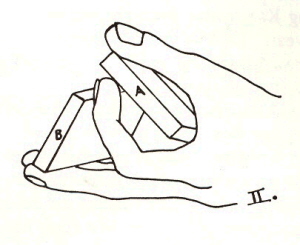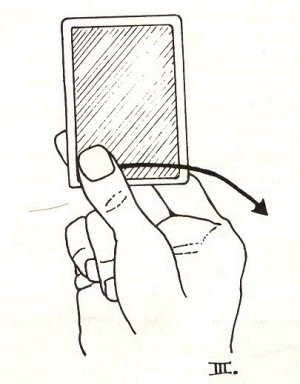 |
 |
 |
Page 33 Winter 1987-88
|
TIPS & TRICKS
A One-Hand Cut & Fan by Emory Kimbrough
If
you would like to extend your juggling skills to include some fancy moves
with a deck of cards, then start by learning one-hand cuts and fans.
These
flourishes will impress onlookers far more than such relatively
simple manipulations ought to. Any deck of cards will do for the
one-hand cut, although people with smalI hands may find bridge-size
cards easier to handle than poker-size.
You
should be much more selective, however, in choosing cards for the
onehand fan. If the cards do not smoothly glide over one another,
then even an expert cannot make a fan free of irregularly spaced
clumps. Tahoe and Club casino cards made by the Arrco Company fan
very well.
The
simplest one-hand cut is called the Charlier cut. Turn your left
hand palm-up, and place one long edge of the deck along the
fingertip pads. (Yes, right-handed people often use their left hand
for this.) The pad of your thumb should naturally come to rest in
the middle of the other long edge. An almost imperceptible rocking
forward of your outer thumb joint will alIow the hand of the deck
nearest your body to fall into the palm (ill. 1).
Curl in your index finger slightly so that its fingertip presses up under the outside left comer of the packet of cards you dropped into your palm - packet A. Push upwards with the index finger, levering up the outside edge of the dropped packet A to form an inverted V with the other cards - packet B. Now
comes the tricky part. Slowly lower your second, third and fourth
fingers slightly. The upper edge of packet B should slide down the
fingernail of the index finger (ill. 2). Now
carefully curl in your index finger, lowering packet B as the
index finger's tip slides down the face of packet A. B should now
be well below A. Firmly push down and out on A with your thumb
while pulling in on B with your second, third and fourth fingers,
snapping the packets together to complete the cut.
The one-hand fan is easier to master than the cut. Using your right hand, grip the inner left comer of the face-down deck so that the pad of the thumb presses that corner firmly against the outer joint of the second finger. The inner right comer of the deck should be close to the middle joint of the first finger.
The
first finger also supports the deck, but the second finger is
dominant. The third and fourth fingers, curled into the palm, never
touch the deck. Rapidly and firmly arc your thumb to the outside
while your first and second fingers simultaneously curl into the
palm. The motion is almost identical to snapping your fingers (ill.
3).
Within
reason, the quicker and more forcefully you make this snap, the
better the fan will be. Many card handlers prefer to add the third
finger to the face of the deck. The larger part of the thumb's
pressure will then act on the pad of the third finger, but the
snapping action remains the same. In either case you can expect to
litter the floor several times before you master a fan! (Emory
Kimbrough is active in the performing arts of juggling, magic and
comedy. Residing in Montgo1hery, |
 |
 |
 |